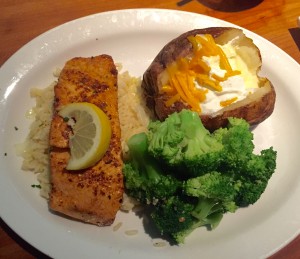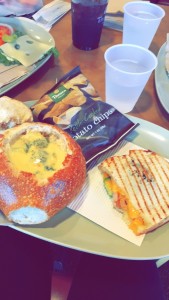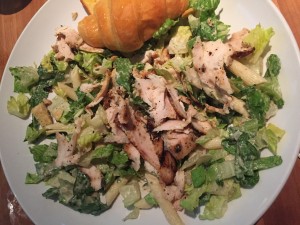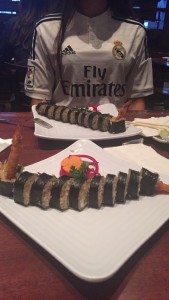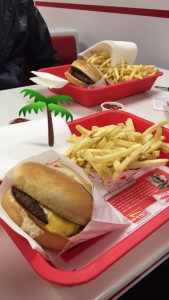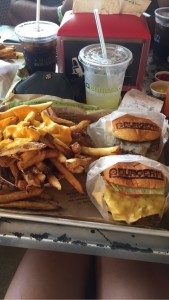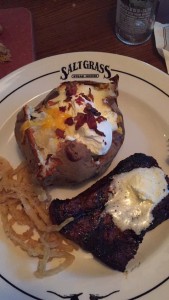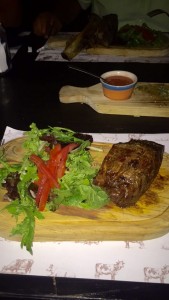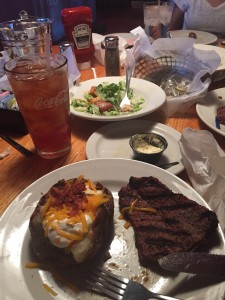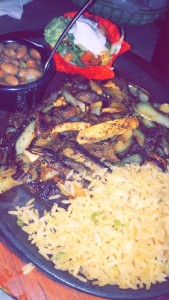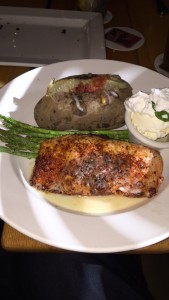During the summer, I monitored what I ate and how that affected my daily life and sleep. Given that I slept in most days, I would skip breakfast because I was sleeping so my first meal would be lunchtime around noon to one. I would typically eat lunch with my mom. I would have salmon with broccoli and a baked potato or a sandwich with soup or salad.
Other days I would have fresh sushi with shrimp, crab, avocado, and cream cheese. I would also eat a chicken Caesar salad for lunch. Occasionally if I was in a hurry I would eat Chick-Fil-A or In-N-Out. If I were at home with friends, I would order pizza from Pizza Hut. If I wanted a snack I would make myself toast with avocado topped with pepper and salt.
For dinner, it would range from my mom’s homemade dishes to eating out at restaurants. I definitely notice the difference between eating out in the United States as opposed to France. “For the first time ever, people in the U.S. are spending more money dining out than buying groceries” (Americans). On the weekends, I would never eat at home. My family and I always go to different restaurants from Friday to Sunday and eat dinner at home on the weekdays. In France, my host family never eats out, not even on the weekends. On Sunday, most restaurants and stores are closed so there is the strict emphasis of being indoors with family. In the United States, Sunday is the busiest day for restaurants because lots of families eat out after church. In fact, a case study for restaurant queuing model showed that “the utilization rate at restaurants is very high during lunch and dinner time on Saturdays and Sundays” (Dharmawirya 1). It is so interesting to find how empty the streets are on Sundays in France – very few people and cars roam the streets of Angers.
On the weekends, my dinners in the United States would consist of a good steak from a steakhouse with some type of green vegetable: broccoli, green beans, or asparagus accompanied with a baked potato and a Caesar salad as an appetizer. My steak would be highly seasoned similar to Burgandy’s saupiquet dish as Waverly Root stated in The Food of France (191).
Another common dinner meal of mine would be pasta. I love Chicken Fettuccini Alfredo or Chicken Parmesan. I would also eat Beef and Chicken Fajitas with rice and beans. One of my other favorite meals is grilled chicken with a side of rice and vegetables. I would also eat ‘Paella,’ which is “rice served with seafood” (Waverley 330) as they eat in Provence.
If my family and I were to Barbecue, (which is very rare to do in France) we would make Steak or Cheeseburgers and I would take off the bread and top it with avocado.
On the other hand, during the weekdays, I would eat my favorite meals my mom would cook. For instance, she would cook ‘Milanesa,’ which is a typical Mexican dish that is a very thin, breaded steak accompanied with edamame or asparagus. I would also commonly eat salmon and fish. Another dish is bacon-wrapped chicken with rice. I would eat Stir Fry, which consists of chicken, broccoli, bell peppers, and other vegetables.
When I would wake up for breakfast, my mom would make pancakes. Sometimes I would eat cereal, other times I would drink a protein shake before or after exercise. Other times I would eat a big breakfast like scrambled eggs with ‘chorizo’ or over easy eggs accompanied with ham and beans. In France, my host mom was extremely surprised when I told her about a typical breakfast I would have in the United States. She said she only drinks coffee and eats bread for breakfast, whereas I have always grown up with the idea that breakfast is the most important meal of the day and it is very bad to skip it. In fact, an Australian study on skipping breakfast stated, “skippers were more likely to be dissatisfied with their body shape and to have been on a diet to lose weight than those who ate breakfast” (Shaw).
I mostly miss going to my kitchen, entering my pantry, and grabbing whatever I wanted. In my host family’s house, they don’t even have a pantry. They also have a very small fridge. Their kitchen fridge is the size of my little fridge that my family has upstairs. Therefore, I believe my host parents go to the market and super market more often and only buy what they need for the week so that explains the small amounts of food in the refrigerator. Actually, farmer’s markets are “alternatives for consumers and opportunities for communities” (Guthrie). Farmer’s markets have fresher produce and allows a customer the chance to roam and make conversation as opposed to the quick trip to the supermarket.
Furthermore, another thing I have noticed that is not necessarily food but a healthy part of any diet is water consumption. Back home I would carry my little gallon of water and refill it every day. I would track on my FitBit how many ounces I would drink. Being in France, I realized I drink very little water compared to how much I used to drink. The convenience of having water fountains in the United States was definitely taken for granted. I have not seen a single water fountain in France. I assumed it was a problem with the tap water, but it is in fact drinkable. As a matter of fact, the levels on contamination in “drinking water were not greater than the health-based drinking-water concentrations that have been defined for other countries” (Boiteux). Ultimately, comparing two distinct countries truly gives you insight on cultural differences.
Also, HOW you eat is very distinct in both countries. In the United States, it is very common for one to have a quick lunch since they have thirty minutes to an hour of a lunch break. In France, eating fast or in a hurry is considered rude or disrespectful. The use of any electronic device at the dinner table is not common whatsoever. I have yet to encounter someone with his or her phone, tablet, or computer at a restaurant or café. I am currently getting strange looks from people passing by as I have my laptop on the table. In the United States, you will see people going to Starbucks to get some work done and calling that normal. In Europe however, “Starbucks is embarking on a multimillion-dollar campaign to win over more of Europe’s coffee aficionados” (Alderman). Especially given that the coffee culture is different in the U.S. and in Europe.
In addition, the French truly emphasize the number of courses you eat per meal. They set out the appetizer, which consists of bread and fruit typically. My host family sometimes has a course before the appetizer, which is olives, peanuts, and wine. As Waverley Root states, “instead of an artificially prepared aperitif, you can very well prelude your meals with a glass” (53) of wine. Then we move on to the next entrée, which is typically the biggest course. I have eaten either pizza, ham and potatoes, chicken and green beans, or salad for the main course. I have realized steak for dinner is not common or much meat for that matter. For dessert, I have had a fruitcake, ice cream, or apples. No one gets up from the table until the last person finishes eating. I have noticed the meals in France are much more respected than in the United States. For instance, they might take it offensive if you don’t finish everything on your plate or if you leave the table at all during dinnertime. In contrast, it is normal if you do not eat an appetizer in the United States or don’t order dessert. It’s also acceptable if you can’t finish everything on your plate, which leads me to my theme.
A contrasting topic that really caught my attention is food waste (or lack thereof), which is what I hope to look into more thoroughly throughout this semester. In the United States, it is very common to see people at restaurants leave little bits of food on their plates once they have finished their meal. In contrast, all the plates I have seen in France are literally wiped clean after every meal and it even looks as clean as if there were no food there to begin with. If I happen to leave a little food left over on my plate, whether at a restaurant or with my host family, they will bring it up and ask if you did not like it. Therefore, I believe food waste is very uncommon and minimal in France as opposed to America. On that note, “60 million metric tons of food is wasted a year in the United States, with an estimated value of $162 billion” (Nixon). People all over the world recognize that food waste is an important topic. However, in the “United States alone, about 40 percent of all food, worth an estimated $165 billion, is wasted” (Gardiner).
Furthermore, it is so common to ask for a to-go box or container back home, whereas that is extremely rare in France. I would imagine they would consider that to be rude. Plus, I feel like most of the time that I would order a to-go box for my leftovers at a restaurant in Texas, I sometimes would forget about it and end up throwing it away. My dad has always taught me to never leave any food on my plate, but since I am such a picky eater it’s very hard for me to finish everything. My first embarrassing encounter was the first dinner at my host family’s house. I realized my host parents ate everything on their plate, but at that time I didn’t think much of it. Once I was full and finished, they picked up my plate and gave it to the dog rather than throw it in the trashcan. In addition, the very little water I left in my glass was thrown to the plants outside. I felt so embarrassed and definitely learned my lesson so now I try to force myself to eat everything, whether I like it or not. Eating everything on your plate in order to not waste food is something that can be easily done by everyone, but based on where you are geographically located and the type of culture you were raised in is unquestionably transparent, especially in France.
REFERENCES:
1. Alderman, Liz. “In Europe, Starbucks Adjusts to a Café Culture.” The New York Times. 30 March 2012.
2. “Americans Spend More on Dining Out Than Groceries For the First Time Ever.” Fox News. 15 April 2015.
3. Boiteux, Virginie. “National Screening Study on 10 Perfluorinated Compounds in Raw and Treated Tap Water in France.” Environmental Contamination and Toxicology.
http://link.springer.com/article/10.1007/s00244-012-9754-7
4. Dharmawirya, Mathias and Adi, Erwin. Case Study for Restaurant Queuing Model. Social Science Research Network. 1 January 2011. http://papers.ssrn.com/sol3/papers.cfm?abstract_id=2014470
5. Gardiner, Beth. “The Economic and Environmental Costs of Wasted Food.” The New York Times. 23 April 2014.
6. Guthrie, John. “Farmer’s Markets.” Emerald Insight: British Food Journal. 2006.
http://www.emeraldinsight.com/doi/abs/10.1108/00070700610676370
7. Nixon, Ron. “Food Waste is Becoming Serious Economic and Environmental Issue.” The New York Times. 25 February 2015.
8. Root, Waverley. “The Food of France.” pg. 53
9. Root, Waverley. “The Food of France.” pg. 191
10. Shaw, Mary E. “Adolescent Breakfast Skipping.” The University of Queensland Australia. 1 January 1998.
